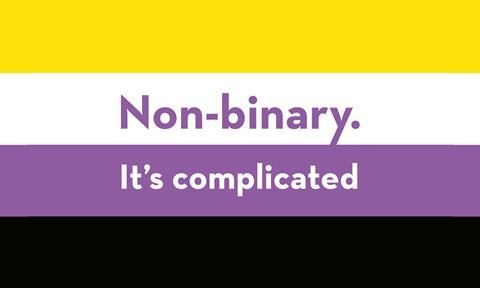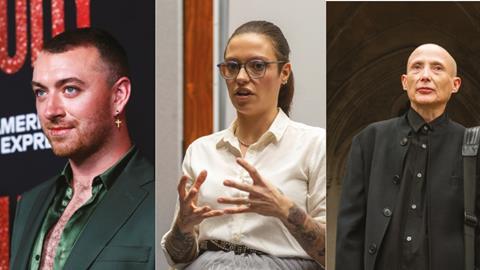Beware of strong opinions and easy answers, says the Evangelical Alliance’s Peter Lynas. Behind the rise of sometimes-confusing gender labels are real people whom Christians are called to love
It is more than two years since the singer Sam Smith famously came out as nonbinary declaring: “I’m not male or female” and changing their pronouns from he/him to they/them. Actor Elliot Page, singer Demi Lovato and author and activist Jack Monroe are among other high-profile, non-binary celebrities. This summer Emma Corrin, who played Princess Diana in The Crown, posted pictures of herself in chest binders on Instagram and added the pronouns she/they.
These stories resonate because, confusing as they may be, they impact people we know and love. What happens in the public arena plays out in families and communities everywhere as people wrestle with what it means to be human, who they think they are and how to be happy with their lives. In recent years, many church youth groups have faced difficult questions about whether someone can change their sex or gender and even whether those categories are still relevant. Some questions provide opportunities to discuss gender stereotypes; some, for example around the use of bathrooms or overnight accommodation, present real pastoral challenges, while others reflect the deep uncertainty of our culture.

UNDERSTANDING THE TERMINOLOGY
If you are confused, you are not alone, so let’s define some terms before wrestling with the cultural, biblical and pastoral issues:
BIOLOGICAL SEX defines a person as male or female based on sex organs, reproductive capacity and chromosomes which, in turn, affect secondary sex characteristics such as body hair, bone structure and muscle density.
GENDER is a more contested term and has, historically, been used interchangeably with sex. Today it is generally used to refer to the psychological, social and cultural aspects of being male or female and includes gender identity and expression.
NON-BINARY is typically used by those who don’t identify as exclusively male or female, or who may identify with aspects of both. They may feel their gender is fluid (ie it can change and fluctuate) or permanently don’t identify with one gender. Other terms commonly used by non-binary people include genderqueer, agender, gender-fluid, bi-gender, pangender and gender non-conforming. In a recent survey by The Trevor Project, more than 100 different terms were used by young people to describe their gender identity. Some people identify as non-binary and as a man, woman or trans – or something else. Non-binary people most commonly go by they/ them pronouns, but as we saw with Emma Corrin, it is not unusual to go by a mix, such as she/they.
There is also some overlap with the transgender (trans) community. Some non-binary people will identify as trans, but others don’t.
TRANSGENDER is an umbrella term to describe people who consider their gender to not be the same as, or to not sit comfortably with, their birth sex. However as Suzannah Weiss, writing for Teen Vogue, put it: “I personally don’t feel I was born in the wrong body; I feel I was assigned the wrong gender based on people’s misconceptions about my body. My non-binary identity isn’t the result of my brain chemistry; it’s a reflection of my disagreement with the whole system of gender.”
Another possible area of confusion is around being intersex:
INTERSEX is the term used to describe a person born with ambiguous sex characteristics or anatomy that does not fit the typical definitions of male or female bodies. However, most intersex people do not describe themselves as nonbinary and most non-binary people are not intersex.
In reality, almost all of the terms above are contested, and are used by different people in different ways. These aren’t just medical terms or philosophical notions; they affect real people in very real ways.
CULTURAL CONTEXT
Challenging gender norms is not a new idea. Androgyny has been around since ancient times. The word itself brings together the Greek terms for man and woman. Being non-binary and androgynous are not the same but there are overlaps – so we are dealing with something that is both very old and very new.
Cultural expressions of gender also change; 100 years ago, boys wore pink and girls wore blue. The singer Billie Eilish has called gender roles “ancient”. Eilish continues to identify as female, but talks of wearing ‘boys’ clothes and has launched her own gender-fluid kids clothing line.
Reliable statistics are scarce, but the number of people identifying as non-binary appears to be growing. A 2011 survey, conducted by the Equality and Human Rights Commission, found that 0.4 per cent of respondents identified as non-binary, although the survey was self-selecting. The UK’s main gender identity clinic for people under 18 has seen a rise in those who identify as non-binary or genderqueer, now making up eleven per cent of referrals. In a 2017 government survey, 57 per cent of trans respondents under 35 identified as non-binary. Those who were nonbinary talked of their struggles to fit in and had some of the lowest life satisfaction scores. A 2017 University of California study found that 27 per cent of youth aged twelve to 17 in California were viewed to be gender nonconforming by their peers.
There is limited medical research into non-binary. Gender dysphoria is a rare medical condition recognised by the NHS as being where “a person experiences discomfort or distress because there’s a mismatch between their biological sex and gender identity”. There are approximately 15,000 gender identity patients in the UK. However, many who identify as non-binary don’t experience gender dysphoria and aren’t pursing a medical pathway, so they would not be included in this number.

WHAT DOES THE BIBLE SAY?
Biblically, it’s also complicated and cannot be reduced to simply turning to a couple of proof texts. We are created, relational beings searching for connection, meaning, significance and our place in a broken and complex world. Genesis 1-2 teaches we are created male and female, made in God’s image. God created human beings as sexed beings to reflect his image.
Marc Cortez, who writes on theological anthropology, comments: “Although recognising that God is not a sexually differentiated being as humans are, we can affirm that human sexuality mirrors something important about the divine nature.” Genesis 2 tells us that Eve is human like Adam, but female. As Preston Sprinkle notes in his paper, A biblical conversation about transgender identities, the Hebrew word kenegdo “highlights Eve’s equality and sex difference”.
In Matthew 19, Jesus cites Genesis 1 in a discussion on marriage, affirming the ongoing relevance of God’s creation of humans as male and female. Elsewhere, when the Bible mentions any cross-gender behaviour (e.g. Deuteronomy 22:5; 1 Corinthians 6:9-10; 11:2-16) it does so negatively.
‘I identify as Korean’

Social media star Oli London came out as non-binary and uses the pronouns “they”, but has also undergone “racial transition surgery” and now identifies as Korean. They said they felt trapped in their own body and have spent a reported £175,000 on 18 cosmetic surgeries. There has been significant backlash to Oli’s decision to identify as Korean. Oli can’t understand why people are taking offence and commented: “People are so quick to judge these days, it’s fine to identify as 100 different genders but why can’t I identify as Korean? I don’t see why people take offence.”
In response, some argue that Genesis is using merisms like ‘day and night’ or ‘male and female’ to cover everything in-between. However, while dawn and dusk are mentioned elsewhere as alternatives to night and day, humans are only ever identified as male and female. Others point to Jesus’ acceptance of eunuchs as affirming a form of gender variance. However, while they may have been castrated or infertile, they were still identified as male within their culture, not as a third, or different, sex. Others point to Galatians 3:28 where Paul concludes a lengthy argument noting there are neither male nor female, all are one in Christ Jesus. However, Paul is not denying difference, rather declaring that Gentiles can become Christians without first needing to become Jews. Some argue, based on Matthew 22:30, that as there will be no marriage in heaven, consequently, we are moving to a time when sex and gender do not matter. However, Jesus does not say we will be sexless in the resurrection, nor does the Bible describe angels as sexless.
The physical, human body has great significance within Christian understanding, from creation through incarnation to the resurrection and ascension. The Bible recognises and celebrates two sexes. The text does not seem to allow for, and actually on occasion prohibits, identifying as different from your biological birth sex. That said, we need to understand what the Bible means when it says we are made “male and female” and not unwittingly accept society’s stereotypes about sex and gender. The Church must acknowledge that it has shaped and accepted cultural stereotypes that have been deeply unhelpful. My children were at a Christian event recently where the boys played sport and went on an adventure while the girls painted their nails!
RESPONDING PASTORALLY
As with all aspects of our ministry and life, we should seek to respond with compassion and empathy, meeting people at their point of need as Jesus did with the woman at the well in John 4. Our encounters should be marked with integrity, respecting sex differences and encouraging caution when considering more invasive procedures. Finally, in a relationship with someone who identifies as non-binary, we should seek to rise above the sex and gender culture wars, drawing the individual to the transformative power of a relationship with Jesus and the Holy Spirit.
Paul’s teaching on Gnosticism is also helpful in responding to those who talk about a ‘real me’ trapped in the wrong body or who point to an ‘internal sense of self’. Paul clearly sets out, in 1 Corinthians 6, that the body is the “temple of the Holy Spirit” (v19) and so we should “honour God” with our body (v20). He is critical of thinking that views the created order, and particularly the body, as problematic. These ideas have more to do with ancient Greek Platonism than following Jesus. If any of us thinks having sex with whoever we please, or eating whatever we like, is fine because it’s just about our physical bodies and not the real us, Paul says “no”. If we think the gospel is just about saving souls and that caring for physical creation (including ourselves) isn’t important, Paul firmly disagrees. We need to wrestle with the resurgence of these ideas, seeking to live biblically in a culture of gender confusion. The question is not how do I see myself? but how does God see me?
IDEOLOGY AND BIOLOGY ARE OFTEN CONFUSED, AS ARE FACTS AND OPINIONS
How to address a non-binary person, and which pronouns to use, is a contentious issue. For some Christians, courtesy leads them to use the name and preferred pronoun of the person. For others, the use of pronouns leads to confusion and, ultimately, results in their participation in, and perpetuation of, deception. The context may be important. At the point of welcome, using preferred names and pronouns may be more appropriate; but as the relationship and discipleship journey grows, there may be more space to raise questions. When I meet someone who is trans or non-conforming, I will use the name they tell me. Anything else will end the conversation. Daniel took the name Belteshazzar, drawing the line instead at consuming defiled food and wine (Daniel 1:7-8). However, I tend to avoid pronouns where possible and I don’t agree with moves to compel the use of preferred pronouns.
We should rise above sex and gender culture wars, drawing people to the transformative power of a relationship with Jesus
CHANGING ATTITUDES
The cultural conversation is changing quickly. In 2015, Rachel Dolezal found herself in the midst of a media storm after self-identifying as black. In 2018, Emile Rateband launched a legal battle to change his age by 20 years to boost his dating prospects, saying: “We live in a time when you can change your name and change your gender. Why can’t I decide my own age?”
The public space around gender, sex and sexuality is becoming increasingly fragmented and contentious. The Keira Bell case concluded that young people were unlikely to be able to properly consent to puberty blockers and other treatments associated with gender dysphoria, given the longterm consequences. Bell, now 23, has detransitioned after being given puberty blockers at 15 and having a double mastectomy at the age of 20. Maya Forstater recently won a legal case protecting her right to believe that people cannot change their biological sex. JK Rowling has tweeted about sex being real and her concerns about the erasure of women. This certainly created a stir, with staff at her publishing house calling for her to be dropped and Harry Potter actors criticising her, but Rowling has also created space for others to raise concerns. Fair Play For Women recently won a challenge over guidance given to transgender people and others on how to detail their sex in the 2021 census. Stonewall is coming under pressure for its workplace diversity training on gender, with the Equality and Human Rights Commission and a number of other government departments withdrawing from the scheme.
There is growing concern around the risks of self-identification when it comes to gender. The government in Westminster has decided against this route but it is still being considered in Scotland, and organisations such as Stonewall continue to lobby for it. Questions are being asked about those born male being housed in female prisons, about protecting female-only spaces in domestic violence hostels and the erasure of sex-based language with the rise of terms such as ‘birthing parent’. The tide appears to be turning in some of these contested areas. Many parents I speak to, regardless of their faith background, are concerned about the information their children are given in school and can access on social media. Ideology and biology are often confused, as are facts and opinions. The next few years are likely to see more people push the gender boundaries, while others will continue to challenge gender stereotyping and the undermining of sex-based rights.
These conversations offer challenges and opportunities to Christians. There are unhelpful gender stereotypes that should be challenged. Conversations around race, age and the increased use of AI will push our understanding of what it is to be human. These issues move beyond proof texting and will require more rigorous theological thinking. Our culture is wrestling with deep questions of identity that create missional moments: Which you is you? Who are we? How do you live the good life? Why are we here? These are fundamental questions about meaning, significance, connection and our place in the world. It’s complicated, but they offer incredible opportunities to unpack the good, true and beautiful story of God.
Click here to read Libby’s transgender story. We will be publishing another story in next month’s edition





































